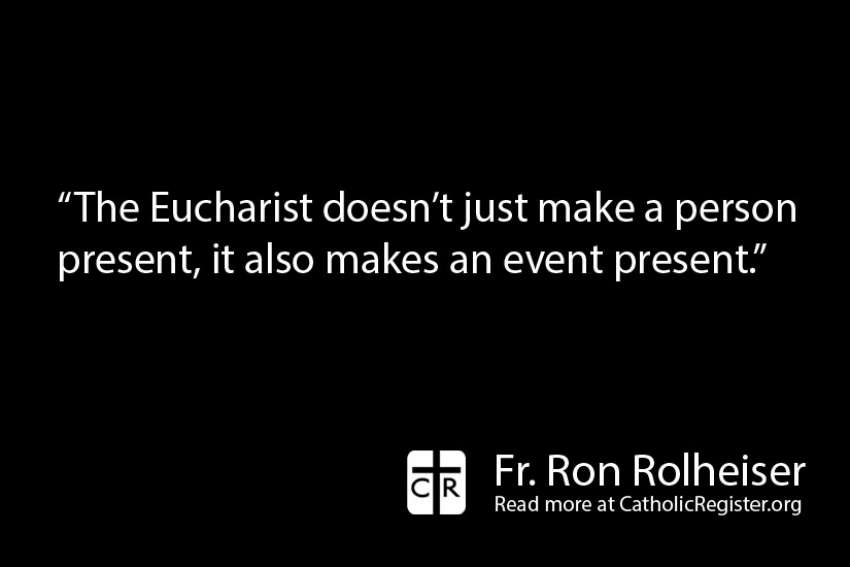He was commenting on the Eucharist and our lack of understanding of its full richness when he highlighted this contrast: If you stood outside of a Roman Catholic church today as people were coming out of the church and asked them: “Was that a good Eucharist?”, most everyone would answer on the basis of the homily and the music.
If the homily was interesting and the music lively, most people would answer that it had been a good Eucharist. Now, he continued, if you had stood outside a Roman Catholic church 60 or 70 years ago and asked: “Was that a good Mass today?” nobody would have even understood the question. They would have answered something to the effect of: “Aren’t they all the same!”
Today our understanding of the Eucharist, in Roman Catholic circles and indeed in most Protestant and Anglican circles, is very much concentrated on three things: the liturgy of the Word, the music and communion. Moreover, in Roman Catholic churches, we speak of the real presence only in reference to the last element, the presence of Christ in the bread and wine.
While none of this is wrong — the liturgy of the word, the music and communion are important — something is missing in this understanding. It misses the fact that the real presence is not just in the bread and wine, it is also in the liturgy of the Word and in the salvific event that is recalled in the Eucharistic prayer, namely, the death and resurrection of Jesus.
Most church-goers already recognize that when the scriptures are celebrated in a liturgical service God’s presence is made special, more physically tangible, than God’s normal presence everywhere or God’s presence inside our private prayer.
The Word of God, when celebrated in a church is, like Christ’s presence in the consecrated bread and wine, also the real presence.
But there’s a further element that’s less understood: The Eucharist doesn’t just make a person present, it also makes an event present. We participate in the Eucharist not just to receive Christ in communion, but also to participate in the major salvific event of his life, his death and resurrection.
What’s at issue here?
At the Last Supper, Jesus invited his followers to continue to meet and celebrate the Eucharist “in memory of me.” But his use of the word “memory” and our use of that word are very different.
For us “memory” is a weaker word. It simply means calling something to mind, remembering an event like the birth of your child, your wedding day, or the game when your favourite sports team finally won the championship. That’s a simple remembering. It can stir deep feelings but it does nothing more.
Whereas in the Hebrew concept out of which Jesus was speaking, memory, making ritual remembrance of something, implied much more than simply recalling something. To remember something was not simply to nostalgically recall it. Rather it meant to recall and ritually re-enact it so as to make it present again in a real way.
For example, that’s how the Passover Supper is understood within Judaism. The Passover meal recalls the Exodus from Egypt and the miraculous passing through the Red Sea into freedom. The idea is that one generation, led by Moses, did this historically, but that by re-enacting that event ritually, in the Passover Meal, the event is made present again, in a real way, for those at table to experience.
The Eucharist is the same, except that the saving event we re-enact is the death and resurrection of Jesus, the new Exodus.
The Eucharist, parallel to a Jewish Passover meal, remakes present the central saving event in Christian history, namely, Jesus’ Passover from death to life in the Paschal mystery. And just as the consecrated bread and wine give us the real presence of Christ, the Eucharist also gives us the real presence of the central saving event in our history, Jesus’ passage from death to life.
Thus at a Eucharist, there are, in effect, three real presences. First, Christ is really present in the Word, namely, the scriptures, the preaching and the music. Christ is also really present in the consecrated bread and wine — they are his body and blood. And Christ is really present in a saving event — Jesus’ sacrificial passing from death to life.
And so we go to Eucharist not just to be brought into community by Jesus’ word and to receive Jesus in communion, we go there too to enter into the saving event of his death and resurrection. The real presence is in both a person and in an event.
(Fr. Rolheiser can be reached at ronrolheiser.com)


